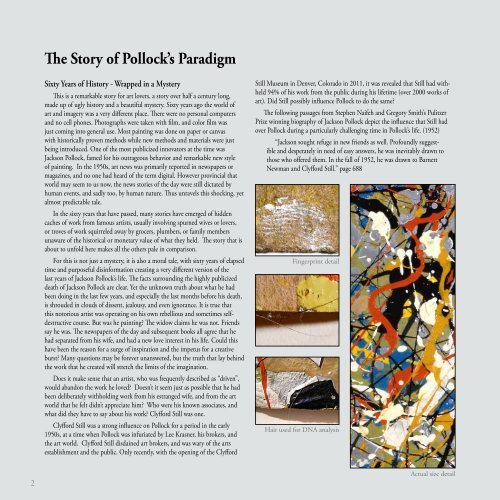Pollock's Paradigm
You also want an ePaper? Increase the reach of your titles
YUMPU automatically turns print PDFs into web optimized ePapers that Google loves.
The Story of Pollock’s <strong>Paradigm</strong><br />
Pollock’s <strong>Paradigm</strong> A1<br />
Size: 39 x 47 in (99.0 x 119.4 cm) on artboard<br />
Fractal analysis completed by Professor Richard Taylor in April, 2005<br />
Materials analysis completed 2010<br />
Sixty Years of History - Wrapped in a Mystery<br />
This is a remarkable story for art lovers, a story over half a century long,<br />
made up of ugly history and a beautiful mystery. Sixty years ago the world of<br />
art and imagery was a very different place. There were no personal computers<br />
and no cell phones. Photographs were taken with film, and color film was<br />
just coming into general use. Most painting was done on paper or canvas<br />
with historically proven methods while new methods and materials were just<br />
being introduced. One of the most publicized innovators at the time was<br />
Jackson Pollock, famed for his outrageous behavior and remarkable new style<br />
of painting. In the 1950s, art news was primarily reported in newspapers or<br />
magazines, and no one had heard of the term digital. However provincial that<br />
world may seem to us now, the news stories of the day were still dictated by<br />
human events, and sadly too, by human nature. Thus unravels this shocking, yet<br />
almost predictable tale.<br />
In the sixty years that have passed, many stories have emerged of hidden<br />
caches of work from famous artists, usually involving spurned wives or lovers,<br />
or troves of work squirreled away by grocers, plumbers, or family members<br />
unaware of the historical or monetary value of what they held. The story that is<br />
about to unfold here makes all the others pale in comparison.<br />
For this is not just a mystery, it is also a moral tale, with sixty years of elapsed<br />
time and purposeful disinformation creating a very different version of the<br />
last years of Jackson Pollock’s life. The facts surrounding the highly publicized<br />
death of Jackson Pollock are clear. Yet the unknown truth about what he had<br />
been doing in the last few years, and especially the last months before his death,<br />
is shrouded in clouds of dissent, jealousy, and even ignorance. It is true that<br />
this notorious artist was operating on his own rebellious and sometimes selfdestructive<br />
course. But was he painting? The widow claims he was not. Friends<br />
say he was. The newspapers of the day and subsequent books all agree that he<br />
had separated from his wife, and had a new love interest in his life. Could this<br />
have been the reason for a surge of inspiration and the impetus for a creative<br />
burst? Many questions may be forever unanswered, but the truth that lay behind<br />
the work that he created will stretch the limits of the imagination.<br />
Does it make sense that an artist, who was frequently described as “driven”,<br />
would abandon the work he loved? Doesn’t it seem just as possible that he had<br />
been deliberately withholding work from his estranged wife, and from the art<br />
world that he felt didn’t appreciate him? Who were his known associates, and<br />
what did they have to say about his work? Clyfford Still was one.<br />
Clyfford Still was a strong influence on Pollock for a period in the early<br />
1950s, at a time when Pollock was infuriated by Lee Krasner, his brokers, and<br />
the art world. Clyfford Still disdained art brokers, and was wary of the arts<br />
establishment and the public. Only recently, with the opening of the Clyfford<br />
Still Museum in Denver, Colorado in 2011, it was revealed that Still had withheld<br />
94% of his work from the public during his lifetime (over 2000 works of<br />
art). Did Still possibly influence Pollock to do the same?<br />
The following passages from Stephen Naifeh and Gregory Smith’s Pulitzer<br />
Prize winning biography of Jackson Pollock depict the influence that Still had<br />
over Pollock during a particularly challenging time in Pollock’s life. (1952)<br />
“Jackson sought refuge in new friends as well. Profoundly suggestible<br />
and desperately in need of easy answers, he was inevitably drawn to<br />
those who offered them. In the fall of 1952, he was drawn to Barnett<br />
Newman and Clyfford Still.” page 688<br />
Fingerprint detail<br />
Hair used for DNA analysis<br />
2<br />
Actual size detail<br />
3


